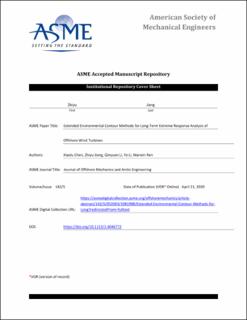| dc.contributor.author | Chen, Xiaolu | |
| dc.contributor.author | Jiang, Zhiyu | |
| dc.contributor.author | Li, Qinyuan | |
| dc.contributor.author | Li, Ye | |
| dc.contributor.author | Ren, Nianxin | |
| dc.date.accessioned | 2021-03-23T21:44:55Z | |
| dc.date.available | 2021-03-23T21:44:55Z | |
| dc.date.created | 2021-01-07T09:47:14Z | |
| dc.date.issued | 2020 | |
| dc.identifier.citation | Chen, X., Jiang, Z., Li, Q., Li, Y. & Ren, N. (2020). Extended Environmental Contour Methods for Long-Term Extreme Response Analysis of Offshore Wind Turbines. Journal of Offshore Mechanics and Arctic Engineering, 142(5): 052003. doi: | en_US |
| dc.identifier.issn | 0892-7219 | |
| dc.identifier.uri | https://hdl.handle.net/11250/2735195 | |
| dc.description | Author's accepted manuscript. | en_US |
| dc.description.abstract | Environmental contour method is an efficient method for predicting the long-term extreme response of offshore structures. The traditional environmental contour is obtained using the joint distribution of mean wind speed, significant wave height, and spectral peak period. To improve the accuracy of traditional environmental contour method, a modified method was proposed considering the non-monotonic aerodynamic behavior of offshore wind turbines. Still, the modified method assumes constant wind turbulence intensity. In this paper, we extend the existing environmental contour methods by considering the wind turbulence intensity as a stochastic variable. The 50-year extreme responses of a monopile-based offshore wind turbine are compared using the extended environmental contour methods and the full long-term method. It is found that both the environmental contour method and the modified environmental contour method, with the wind turbulence intensity included as an individual variable, give more accurate predictions compared with those without. Using the full long-term method as a benchmark, this extended approach could reduce the nonconservatism of the environmental contour method and conservatism of the modified environmental contour method. This approach is effective under wind-dominated or combined wind-wave loading conditions, but may not be as important for wave-dominated conditions. | en_US |
| dc.language.iso | eng | en_US |
| dc.publisher | American Society of Mechanical Engineers | en_US |
| dc.rights | Navngivelse 4.0 Internasjonal | * |
| dc.rights.uri | http://creativecommons.org/licenses/by/4.0/deed.no | * |
| dc.title | Extended Environmental Contour Methods for Long-Term Extreme Response Analysis of Offshore Wind Turbines | en_US |
| dc.type | Journal article | en_US |
| dc.type | Peer reviewed | en_US |
| dc.description.version | acceptedVersion | en_US |
| dc.rights.holder | © 2020 American Society of Mechanical Engineers | en_US |
| dc.subject.nsi | VDP::Teknologi: 500 | en_US |
| dc.source.pagenumber | 14 | en_US |
| dc.source.volume | 142 | en_US |
| dc.source.journal | Journal of Offshore Mechanics and Arctic Engineering | en_US |
| dc.source.issue | 5 | en_US |
| dc.identifier.doi | https://doi.org/10.1115/1.4046772 | |
| dc.identifier.cristin | 1866773 | |
| dc.source.articlenumber | OMAE-19-1129 | en_US |
| cristin.qualitycode | 2 | |

